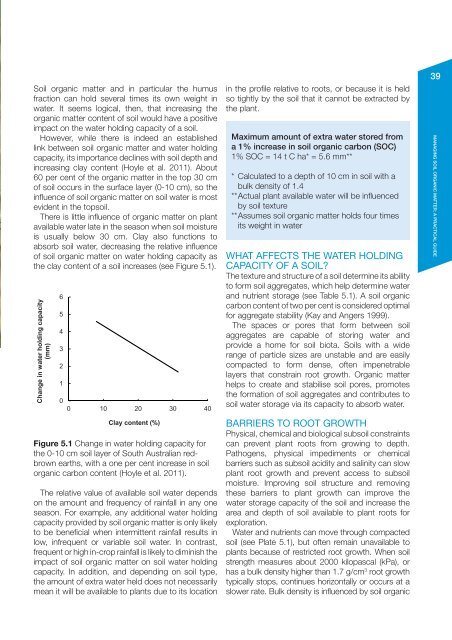managing soil organic matter - Grains Research & Development ...
managing soil organic matter - Grains Research & Development ...
managing soil organic matter - Grains Research & Development ...
You also want an ePaper? Increase the reach of your titles
YUMPU automatically turns print PDFs into web optimized ePapers that Google loves.
Soil <strong>organic</strong> <strong>matter</strong> and in particular the humusfraction can hold several times its own weight inwater. It seems logical, then, that increasing the<strong>organic</strong> <strong>matter</strong> content of <strong>soil</strong> would have a positiveimpact on the water holding capacity of a <strong>soil</strong>.However, while there is indeed an establishedlink between <strong>soil</strong> <strong>organic</strong> <strong>matter</strong> and water holdingcapacity, its importance declines with <strong>soil</strong> depth andincreasing clay content (Hoyle et al. 2011). About60 per cent of the <strong>organic</strong> <strong>matter</strong> in the top 30 cmof <strong>soil</strong> occurs in the surface layer (0-10 cm), so theinfluence of <strong>soil</strong> <strong>organic</strong> <strong>matter</strong> on <strong>soil</strong> water is mostevident in the top<strong>soil</strong>.There is little influence of <strong>organic</strong> <strong>matter</strong> on plantavailable water late in the season when <strong>soil</strong> moistureis usually below 30 cm. Clay also functions toabsorb <strong>soil</strong> water, decreasing the relative influenceof <strong>soil</strong> <strong>organic</strong> <strong>matter</strong> on water holding capacity asthe clay content of a <strong>soil</strong> increases (see Figure 5.1). Figure 5.1 Change in water holding capacity forthe 0-10 cm <strong>soil</strong> layer of South Australian redbrownearths, with a one per cent increase in <strong>soil</strong><strong>organic</strong> carbon content (Hoyle et al. 2011).The relative value of available <strong>soil</strong> water dependson the amount and frequency of rainfall in any oneseason. For example, any additional water holdingcapacity provided by <strong>soil</strong> <strong>organic</strong> <strong>matter</strong> is only likelyto be beneficial when intermittent rainfall results inlow, infrequent or variable <strong>soil</strong> water. In contrast,frequent or high in-crop rainfall is likely to diminish theimpact of <strong>soil</strong> <strong>organic</strong> <strong>matter</strong> on <strong>soil</strong> water holdingcapacity. In addition, and depending on <strong>soil</strong> type,the amount of extra water held does not necessarilymean it will be available to plants due to its locationin the profile relative to roots, or because it is heldso tightly by the <strong>soil</strong> that it cannot be extracted bythe plant.Maximum amount of extra water stored froma 1% increase in <strong>soil</strong> <strong>organic</strong> carbon (SOC)1% SOC = 14 t C ha* = 5.6 mm*** Calculated to a depth of 10 cm in <strong>soil</strong> with abulk density of 1.4** Actual plant available water will be influencedby <strong>soil</strong> texture** Assumes <strong>soil</strong> <strong>organic</strong> <strong>matter</strong> holds four timesits weight in waterWHAT AFFECTS THE WATER HOLDINGCAPACITY OF A SOIL?The texture and structure of a <strong>soil</strong> determine its abilityto form <strong>soil</strong> aggregates, which help determine waterand nutrient storage (see Table 5.1). A <strong>soil</strong> <strong>organic</strong>carbon content of two per cent is considered optimalfor aggregate stability (Kay and Angers 1999).The spaces or pores that form between <strong>soil</strong>aggregates are capable of storing water andprovide a home for <strong>soil</strong> biota. Soils with a widerange of particle sizes are unstable and are easilycompacted to form dense, often impenetrablelayers that constrain root growth. Organic <strong>matter</strong>helps to create and stabilise <strong>soil</strong> pores, promotesthe formation of <strong>soil</strong> aggregates and contributes to<strong>soil</strong> water storage via its capacity to absorb water.BARRIERS TO ROOT GROWTHPhysical, chemical and biological sub<strong>soil</strong> constraintscan prevent plant roots from growing to depth.Pathogens, physical impediments or chemicalbarriers such as sub<strong>soil</strong> acidity and salinity can slowplant root growth and prevent access to sub<strong>soil</strong>moisture. Improving <strong>soil</strong> structure and removingthese barriers to plant growth can improve thewater storage capacity of the <strong>soil</strong> and increase thearea and depth of <strong>soil</strong> available to plant roots forexploration.Water and nutrients can move through compacted<strong>soil</strong> (see Plate 5.1), but often remain unavailable toplants because of restricted root growth. When <strong>soil</strong>strength measures about 2000 kilopascal (kPa), orhas a bulk density higher than 1.7 g/cm 3 root growthtypically stops, continues horizontally or occurs at aslower rate. Bulk density is influenced by <strong>soil</strong> <strong>organic</strong>39MANAGING SOIL ORGANIC MATTER: A PRACTICAL GUIDE
















